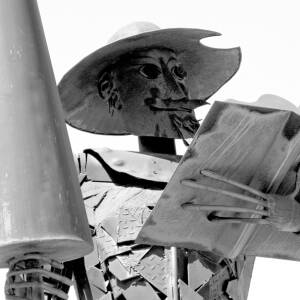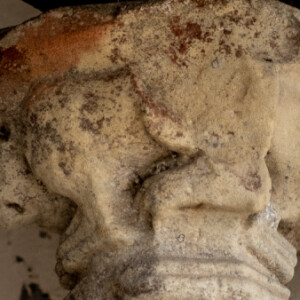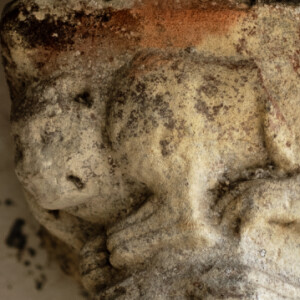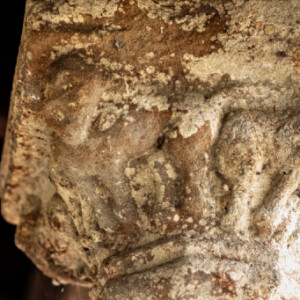A lion I think...
This is a capital from the church of St James the Elder, Moral, Asturias. The church itself looks like 17th century to me, but I think the capitals and windows are pre-romanesque, possibly from an earlier church on the same site but equally possibly from a disappeared church in the locality. Not too distant was a pre-romanesque church of San Sadurnino, of which nothing remains except a lintle. That´s another possibility.
I´ll add another capital or two, and a clearly pre-romanesque window, in extras.
And if you´ll excuse the self-indulgence: I´ve now found a copy of the full version of the George Wright Smith Was Murdered that I mentioned yesterday, and I´ll patch it below.
FULL VERSION
GEORGE WRIGHT SMITH WAS MURDERED
George Wright Smith, my father´s elder brother, was shot dead in Karachi, India, on the 30th June 1937.
George took his first name from his grandfather, a farmer, who was born in Turriff in 1853 and died in Banff in 1935. He took his second name, Wright, from his grandmother, Elspet Wright, who was born in Boyndie, Banffshire, in 1852; married George in Boyndie in October 1874; and died in Banff aged 50, in 1902. In between she was not idle: six daughters and three sons were born in the 17 years between 1875 (Annie) and 1892 (Bessie). Their fifth child, and third son, was William, who in 1908 was a “writer” (law clerk) resident in Glasgow, and who while there met and in April 1909 at Hillhead married, Beatrice Stobie. George was born to William and Beatrice in Glasgow in 1910. The family settled back in Banff and by the time of his death in November 1938 William had become “Hon. Sherriff Substitute” of Banffshire. My father left Banff in 1937 and by the time he went back to visit the family gravestone, from our home in Nairn in 1954, there was no-one from his immediate family still alive there. George, though (I found it later) is on the gravestone, in the cemetery in Banff: William and Beatrice "and their eldest son George Wright Smith, who died in Karachi, India, 30th June 1937". Later in 1954 we moved south to Cambridgeshire and my father did not return.
In 2005 I retired, a few years early, and started to look more seriously at the family history. My father was already dead so whatever he knew (and he never spoke about it) was lost. My mother´s memory had by that time failed her completely. Since George had no wife or child there was nothing to discover about him from the genealogy sites, so I went to the newspaper archives. It ought to be easy enough, I thought: I had the date and place, the name (admittedly it was Smith!), and a Briton murdered in India would probably have been news at the time. I started with the Scotsman and worked through all the papers that had by that time digitised their records. And the story was there and at first glance clear. The Scotsman reported as follows :
SHOOTING TRAGEDY IN INDIA: RAF OFFICER AND ABERDEEN BANK CLERK DEAD: SEQUEL TO PERSONAL QUARREL
Karachi June 30, 1937
Mr George W Smith, British sub-accountant in the Karachi branch of the Chartered bank of India Australia and China, was shot dead in the early hours of this morning, allegedly by Flying Officer W T King of No. 31 Squadron of the Royal Air Force, who was found bleeding from a gunshot wound. The latter was taken to hospital, where he died. Flying Officer King´s wife, it was stated, was a witness of the tragedy. A long-standing dispute over personal affairs led to the tragedy (adds Reuter). Mrs King was present but escaped injury. She has been married six months and during the last three months her husband has been stationed in Karachi.
Police who rushed to the scene of the tragedy found Smith lying dead from a cerebral fracture caused by a bullet. King was lying near suffering from a gunshot wound. Nearby was a seven-chamber British-made automatic revolver with cartridges fired. An inquest was held on Smith on the spot and a verdict that death was due to a gunshot wound was returned. His funeral took place this forenoon (Wednesday). King was rushed to hospital by the police but he died at 5 a.m. An inquest is reported to have been held at the hospital, but the strictest secrecy is maintained as to the verdict. He was buried this evening.
News of the death of Flying Officer W T King was received at the Air Ministry yesterday. It was stated at the Ministry that Flying Officer King was shot in the head. His wife, who was at first believed to have been injured in the affray, was later reported unhurt.
Other papers also had the story, in a very similar form, and Reuters seems to have been the common source. I was not convinced by the account, though, initially because I didn´t think so serious a “long-standing dispute over personal affairs” would be likely to grow up in three months. And it seemed strange that the inquest, which presumably only had to say “death by gunshot wound”, should have been held in secret and reported in “the strictest secrecy”. It sounded as though the “British Raj” was protecting itself, but from what? The Daily Mail, though, had a slightly enlarged story:
A quarrel began in a local club. Smith left Mr and Mrs King, who returned to their apartment next to Smith´s. Smith later in response to calls seized a golf club, ran round to King´s door, and on entering was shot dead by King himself. King then shot at his wife, missed, and turned the gun on himself. He shot himself through the head and fell. His wife ran from the house and went for the police and a doctor. When they returned King was still conscious and vainly tried to fire at them. He then collapsed and later died in hospital.
So Smith and King had a long-standing and evidently bitter dispute but were out together, with Mrs King, at a club? That seemed unlikely. The possibility my mother had raised, of an affair between George and Mrs King remained feasible and would explain the events as reported. But how would my mother have known about it? George would presumably not have reported any extra-marital affairs back to his family, so how had that story started? And – I don´t know, I wasn´t alive in 1937, but the idea that in those reportedly less permissive times, George Smith and Mrs King had involved themselves in an affair only 6 months after her marriage, and let it develop and been discovered, and all in three months, again seemed to stretch plausibility. And there were other possibilities: how long had Flying Officer King been in the club that night? Was he sober? Why and in response to what “calls” did George “seize a golf club” – an action that suggests he knew there was trouble coming? Did he think Mrs King was in danger? Was he going next door to try to rescue her from an attack by her husband? Why else would he behave as he did?
I decided to see what had happened to Mrs King, to find out whether she had left an account with her family. But the press had not given her name, and without her maiden surname, investigation was difficult. So the trail had to be the genealogy sites: Ancestry (the co uk version), search for W T King, marriages, 1936 and 1937, and Kent. And all that produced only one possibility, near Canterbury, but the King was only “W”, not “W T”, and there was no RAF connection, so it was only a long shot. So I extended the search, still using Ancestry, and still found nothing that persuaded me. I decided to write to Banffshire Library to ask whether they had any local press archives that might help me name the only survivor and so trace her descendants. It´s still possible that one day they´ll do me the courtesy of replying, but meanwhile, since I don´t live in the UK, to actually visit local newspapers myself was a difficult proposition.
Then came the breakthrough. It dawned on me that William King was in the RAF so he could have met his bride anywhere, and that the wedding might be from her home and not be in Kent. And if not in Kent maybe not in England, and if not in England maybe not in Ancestry. I also wondered if she and George might have know each other before her wedding, which would explain some anomalies. So I decided to try Scotlandspeople. And there they were: no prior connection between George and the bride but nevertheless: Miss Ruth Leah Macandrew, born in Inverness in 1913, married Flying Officer William Thomas King in Edinburgh, from her parents´ home at 29 Marchmont Rd, in January of 1937. And about the same time, I found via Ancestry the records of two sea voyages of Flying Officer W T King, on the 9 of December 1936 from Bombay to Southampton and on the 13th February 1937 from Southampton to Bombay, both on HMS Strathmore, both giving his home address as Pembridge in Kent. At his wedding though it was given as Karachi.
So it seemed that William King was not, as Reuters suggested, a newcomer to India but was already living there. He had, clearly, returned to the UK for his wedding, and had then returned unaccompanied to India, where Mrs King had joined him three months later. That being the case, Smith and King were longer-standing neighbours than at first appeared, so there could have been the reported “long-standing dispute” between the two men. Though if so, unless Smith had been spending time in Edinburgh, which (according to the shipping line records) he had not, presumably it was not a dispute based on Mrs King.
And by this time I had, through Scotlandspeople and Ancestry, chased up Ruth Leah Macandrew, and I had found her second marriage, and her daughter and her grandson, and I knew her grandson´s name. I wrote to him telling him what I knew and asking what he, or his family, knew. It was no great surprise that he had not known the story; but he asked his mother, Ruth´s daughter, let´s call her F, about it. Bits and pieces came out. Ruth had not told her daughter F about her first marriage or about the sad events in Karachi but in Ruth´s old age F had found in her mother´s possessions a photo of a man in RAF uniform and asked her mother about it, and had then been told about the first marriage, to “Bill”.
Who then was Bill King? He was born in Pembridge, Kent, in 1913, to William Smith King and Florence Ada (ms Winter). I have found William Smith King, and again, as suggested by the use of “Smith” as a second forename, there is a Scottish connection, and he was in Scotlandspeople. He was born in Milton, Glasgow, in 1870, and he grew up in Glasgow. Most of his adult life is not recorded but he married Florence in South Shields, England, in 1905. He was present aged 66 at his son Bill´s wedding on January 7th 1937 at the Manse in Fountainhall Rd, Edinburgh, to Ruth Macandrew, and there gave his occupation as “retired Mechanical Engineer”. After the wedding, apart from a newspaper interview on the death of his son, there is no further record of him. Did he move, or have an address, abroad? Is that why his house was called “Casa Matota” (in one transcript and “Casa Matiota” in another)? Florence Ada Winter is similarly absent from the records, though she may have been a servant in a large house in London in her early 20s. But again I found no trace of her after 1937.
Flying Officer Bill King was born in 1913 and in 1934, aged 21, he was commissioned in the Royal Air Force. He was in No 31 (Army Co-operation) Squadron, which was formed as part of the Royal Flying Corps in Farnborough in 1915 and rapidly moved to the North West Frontier, “ assisting the army in dealing with tribal unrest. Its BE2C biplanes were employed on artillery observation, reconnaissance and ground attack”. In June 1937, the month he murdered George Smith, Bill King will have known of King George VI´s award of its new badge to the squadron. The badge was based on an unofficial emblem, incorporating the Star of India and the Squadron's claim to being the first military unit to fly in India. The squadron´s motto was In cælum indicum primus - 'First into Indian skies'. The BE2C was a two-man twin-wing single-engined fighter and spotter plane. Bill King will presumably have been involved in fighting and in ground-attack (bombing and/or strafing) activities. We are now moving closer to a new understanding of Bill King´s behaviour in June 1937, based on a better-informed newspaper article in the Daily Express.
The Daily Express filed its coverage of the Smith/ King murder on July 1st from Tunbridge Wells, very close to the home of Bill King´s parents in Pembury and very clearly based on an interview with the parents. It goes some way beyond the Reuters-sourced material that the other papers had access to. From the Express we learn that:
· Bill King met Ruth Macandrew in London before he went to India in 1934.
· “ He had loved her for three years and had wooed her by letters sent from his station in India.”
· “ The couple had a week together in Karachi. Then he was sent on active service on the North West Frontier. She stayed at home”.
· “ For two months young King led a flight in operation against rebellious tribesmen. He returned to his bride three weeks ago.”
We already know that the Kings married in January 1937 but that she did not follow him to Karachi till March. They were together in Karachi for only a week before he was sent on active service, returning only 3 weeks before the murder. The Express adds a few details of its own to the account of the killing:
“ Flying Officer King and his wife were at a local club. George Smith was also there. Smith left the party and went home.
“ Flying Officer King and his wife went home together at midnight to their apartment, next door to Smith´s.
“ Smith heard a shout. He picked up a golf club and ran round to the Kings´ door. There he was met by King, who shot him dead with a bullet through the head, fired at close range. Then, it is alleged, turned the revolver to his head, pulled the trigger, fell dying to the floor. His wife rushed out into the street and hailed a passing taxicab, crying: “Police! A doctor!”
“ When police and a doctor arrived half an hour later, King, almost dead but still conscious, lay on the floor, still gripping his revolver. It is alleged he tried to aim it at them. He was disarmed. He collapsed and was taken to hospital, and died six hours later.
“ Mrs King collapsed with nervous prostration and was placed under the closest medical attention. She will be sheltered in the home of Flight Lieutenant Hellier until she returns to England next week.”
“ King was buried last night with full military honours. Over his grave a RAF party fired a salute”.
Obviously one plausible explanation of the events is that Bill King was jealous of what he believed to have been the relationship between his wife and George Smith. My mother believed that, so maybe my father did. But again: how would they know? Only, I think, from the newspaper reports above. Only three people will have known what lay behind the press reports, and only Ruth King lived to tell her story. What she told her daughter, late in her life, was that nothing had ever occurred between her and George Smith more intimate than games of tennis. There is another obvious possibility – one that no modern defence lawyer would fail to mention: Bill King was a young man just back from two months of combat. The words “post-traumatic stress disorder” come easily to mind. Or to the more cynical: a suspicious husband, after a night in a club, with a gun to hand, decided to confront his supposed betrayers. What is clearly not the case though is what my mother´s version said: that Smith and Mrs King were alone in a room when King found them together. The story has to look elsewhere for its explanation.
I have felt aggrieved on behalf of the uncle I never met. The press coverage did not explicitly condemn him as an evil seducer who caused it all, but it insinuated against him. The Express coverage was particularly pernicious, though that may have been the price of access to the King parents. Neither his father nor his uncle, both “prominent lawyers”, and one of them a Lord Lieutenant, came to his defence. The evidence that I´ve been able to find some 80 years later does not support the press innuendo – which in any case would hardly constitute grounds for a murder-suicide. It is hard not to conclude that Bill King was suspicious and out of control, that George Smith was trying in some way to protect Ruth King, and that the possession of a gun gave Bill King the means to commit murder.
And the aftermath: Bill King was an only child, and I could find no trace, after 1937, of his parents. George Smith was unmarried so left no family other than his birth family. His brother John and sister Helen died during the Second World War. His brother William and sister Nina survived him, both died in Hertfordshire in the late 1980s. His father died in November 1938, family history says of a broken heart. His step-mother Jane Smith Simpson Smith died in October 1945. Ruth King returned to the UK in 1937 and remarried the following year. Her second husband, who she met on her return journey, asked her not to talk about what had happened to her in India and she complied with that request. She returned to India, apparently alone, in 1952. Maybe to visit her husband´s grave. I´d like to think she spared a thought for George.
And finally here, and very emphatically: Bill King was not an aggrieved victim, he fired his gun and committed murder. I think it entirely reprehensible, unless the Express has invented the detail, that the RAF should have allowed him his burial with “full military honours”. And now I´ve done all I can to give George a voice.
https://www.ancestry.co.uk/mediaui-viewer/collection/1030/tree/1050817/media/d4f5f714-6376-4f65-8a83-6cae96ba09cd?galleryindex=5&sort=-created
family_history
Comments (69)




Comments
Sign in or get an account to comment.


